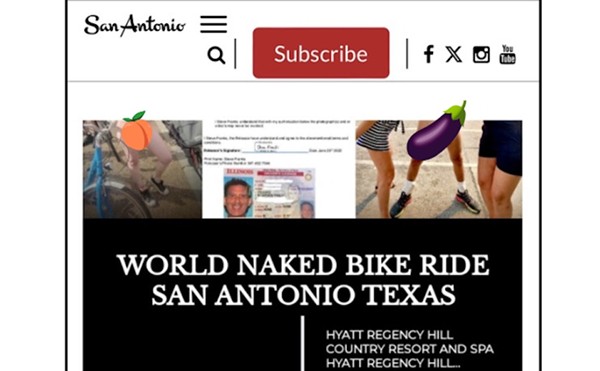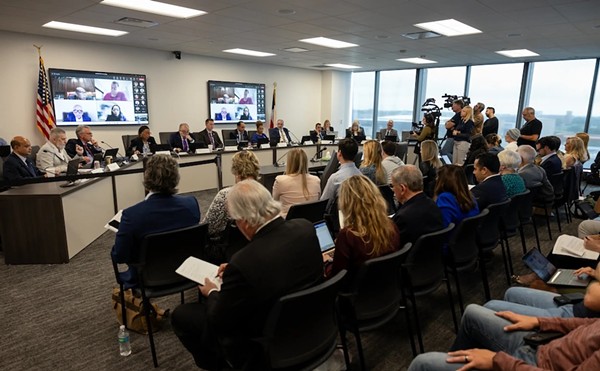BY MICHAEL CARY
Author Luther Lee Sanders in 1975 described the politically powerful Good Government League of San Antonio as a consortium of bankers, real estate brokers, advertisers, builders, manufacturers, retired military officers, doctors, lawyers and pastors whose real purpose was to select and elect candidates for City Council.
Some say the GGL died in the mid-1970s, but others contend it resurfaced in the form of the Chamber of Commerce. A preponderance of evidence supporting the latter argument emerged last week as various meetings were conducted to eyeball the 2003 slate of City Council candidates. A quack spin doctor would devote countless hours to convince the voting public city elections are above-board - but do not believe a word of it. Consider the alleged "debate" the Express-News conducted last week, which it billed as an "editorial board" meeting, or whatever. District 2 Councilman John Sanders squared off against opponents, and the paper gleefully reported the verbal fracas. But was the public invited to witness this debacle? Who attended this democratic process? The E-N did not report that tidbit.
Two public meet-the-candidates mixers were held last week by the Business Coalition of San Antonio. Inexperienced candidates for various City Council offices converged first at the Loopland Hilton Hotel and at the Southeast Side's only presentable venue, the Pecan Valley Golf Club. (What did you expect, the cafeteria at Southeast Baptist Hospital?) Candidates from the various districts dutifully lined up, introduced themselves, and defended their reasons for seeking a place in the amateur political ring at City Hall. Each had 90 seconds to state his or her case. Only two incumbents, District 7's Julián Castro (who courageously mentioned the recently adopted tree preservation ordinance, then steeled himself for an onslaught of developer sharks as the chamber mixer progressed), and District 6's Enrique Barrera participated. Both these meetings seemed more like a chance for business leaders and former City Council members - if not an Amway, or Mary Kay cheerleading seminar - to see if anyone is worth contributing campaign funds to, instead of a bona fide political forum with healthy debates of the perceived issues.
Enough of this vitriolic diatribe. It's exhausting, and we have to pace ourselves. The City Council election is still more than a month away. Bear in mind that we are not endorsing - even if we like some of them, or parts of some of them - any of the candidates that are presented in this newspaper during the ensuing weeks leading up to the Saturday, May 3 municipal election. We'll leave that shady practice to the other news agencies that do business in San An-Toyota.
DISTRICT 9: OLD, NEW CONVERGE ON NORTH SIDE
BY MICHAEL CARY
District 9's shape on the City's map could be loosely described as a giant, irregularly shaped toadstool. Its roots are embedded in the Brackenridge Park and neighboring areas, south of Olmos Park and Alamo Heights. The stem of said toadstool weaves its way north between the two suburbs, squeezes its way through the Loop 410 underpass along Nacogdoches Road, and balloons outward and upward, annexing a path along U.S. 281 until it hits the incorporated City of Bulverde. It also includes a very small neighborhood, Bel Meade, which was built in the 1940s and lies trapped between Fort Sam Houston
| "I see it as a good development agreement and good for the citizens of San Antonio to have their kind of project come to our City." - District 9 incumbent Carroll Schubert, on the PGA Village. |
Civil litigation attorney Carroll Schubert ran for the District 9 City Council seat after Tim Bannwolf hit his two-term ceiling and opposed Ed Garza for mayor. Schubert swore that he would make top city leadership answer for their mistakes. Performance standards would be enforced on city employees. Schubert also planned to cast a critical eye on the management of the City's water and electric utilities, and he favored the hiring of a city auditor that would answer to the City Council, not to the City Manager, which has since been done. Schubert also promised to work to relieve traffic congestion, ensure an adequate water supply and strive to attract new economic development, while working closely with other City Council members.
He led the charge in favor of PGA Village. "I see it as a good development agreement and good for the citizens of San Antonio to have their kind of project come to our City." He also attacked Project Quest, a job skills development program, for not doing its job. "When people are paying tax dollars, they're questioning why. And when they're paying tax dollars, they want accountability and they want to make sure that the people who are benefiting are getting jobs and keeping them."
During the weekly City Council boxing match, Carroll Schubert bears a look of grim determination as he prosecutes city business and demands answers from the City Manager, the City Attorney and other City Hall minions - and they jump higher and faster than the famous jumping frogs of Calaveras County, working feverishly to keep him from scowling them into oblivion. He ignores the taunts of frustrated City Council hecklers who take the podium for three minutes to deride anything having to do with anything, but he perks up and devotes his full attention when one of his constituents approaches to speak. And that, says Schubert, is how he has communicated with his electorate on a daily basis during his first council term.
The two biggest issues are the same ones he identified in 2001. "Traffic and infrastructure, the hardest issues to solve overnight. When I came into office, Blanco Road was languishing, and it is now finished up to Loop 1604. The Huebner Road area is finished. There are street lights in Stone Oak, and traffic lights on U.S. 281 north of Loop 1604. I'm trying to meet the various needs of a large district."
"We're very happy with Councilman Schubert," gushed Nancy Kistler, who lives in Bel Meade with her husband, Colonel Thom, in the shadow of Fort Sam Houston's security fence. "We don't have any problems in our neighborhood. He has been very responsive when he comes out to visit us." Since Bel Meade is an older neighborhood, and unconsolidated soils in San Antonio shift constantly, the streets are in need of repair. Kistler said Schubert has put the isolated area onto the public works list, and she is waiting for the road crews to appear any day, ready to work. "I would vote for Schubert, I'm planning on it," Thom said. In the 2001 election, Schubert, a former assistant to Senator Lloyd Bentsen in the 1970s, collected $87,000 in campaign funds, gathered an endorsement from the Express-News, and garnered 65 percent of the vote in a 14 percent voter turnout to beat out four opponents.
Going into the 2003 City Council election, Schubert has packed $52,170 into his campaign war chest between July and December 2002, with two more reporting dates on the horizon. A partial list of his top contributors reads like a Who's Really Who list at the chamber of commerce: Ernesto
| "He should not have a cakewalk, and he should be held responsible for his actions." - Candidate Tony Garza, who is opposing Carroll Schubert |
He spent $8,400 during the same reporting period, including a $1,433.59 tab in December at the Quarry Golf Club, which is across the street from where he lives. Those green fees can be murder on the pocketbook.
Meanwhile, his opponent Tony R. Garza complains that Schubert was "very arrogant" when he addressed the public on the PGA vote, and that was part of the reason he was motivated to challenge his incumbency at the last minute. "He should not have a cakewalk, and he should be held responsible for his actions," said Garza, a PGA project opponent. "Schubert has a lot of money, but the election shouldn't be about who can raise a lot of money."
Garza said he ran against Howard Peak for mayor four years ago, and was set to challenge Ed Garza in 2001, until he met with him, after which he withdrew from the race and supported Garza's bid for office. He also has worked with anti-establishment Kay Turner in opposing the Applewhite Reservoir, and fought to save HemisFair Arena when the city was set to demolish it to make room for expansion of the Henry B. Gonzalez Convention Center.
He resides in the neighborhood that is situated between San Pedro Avenue and Blanco Road, near Maggie's Restaurant, which puts him nearer to the center of the district than his opponent.
The first thing Garza wanted to talk about was the city's upcoming budget and its projected shortfall of millions. "Schubert has a big axe, to chop the budget, but he has to work with the other city council members. There should be no raised taxes for homeowners." Garza also would work to consolidate the San Antonio Police and Bexar County Sheriff's departments, a proposal that has floated around for years, so city and the county residents would spend an equal amount of money to support law enforcement.
Garza also opposes additional annexation, and doling out tax abatements to corporations."We're running out of money because we're annexing too fast. We can't afford to build the infrastructure we should have, and we should maintain a good neighbor policy with the towns to the north of us. Toyota wasn't looking for tax abatements. I think we can get business to San Antonio and not give it away for free. I was against the PGA, and went many times to speak against it.
A Vietnam Veteran, Garza approves of term limits, but opposes increased council remuneration. "I don't believe the council should be employees of San Antonio because once they get a paycheck, they lose their independence. Serving as a council member is a public service. You serve because you love the city and want to volunteer your services."
Garza worked for the U.S. Immigration Service for nine years, attended San Antonio College, and said he has been active in the community. "I'm trying to organize a grassroots organization, because we don't have enough money to compete with him. I told Schubert I was suspending fund-raising, and challenged him to do so. His campaign strategy is to raise a lot of money for a glossy campaign. He is being very arrogant, and that is a mistake."
That is District 9 in a nutshell. Go with the high-gloss political style of incumbent Carroll Schubert, or with the grassroots, poverty-stricken quest of challenger Tony Garza.
Your choice. •
DISTRICT 10: YOUNG UPSTART VS. THE OLD GUARD
Chip Haass drives through the Northeast Side of town, earnestly pointing at campaign signs planted in the well-manicured front lawns. Haass, a 25-year-old social-studies teacher vying for District 10's open council seat against real estate broker John Clamp, thinks the distribution of signs in this district says a lot about the race.
While he concedes that Clamp's signs outnumber his along major thoroughfares, Haass argues that his signs are more prominent in the district's neighborhoods. That is how Haass breaks down this contest: He's the grassroots champion of the people, while Clamp is the deep-pocket advocate for development.
Haass is an energetic, shoot-the-moon sort of guy. To him, the glass is always half full. But even he is concerned about these campaign signs. He relays a story told to him by former District 10 council candidate Marty Bartlett, who ran for an open seat in 1999 against barbershop owner David Carpenter. Bartlett told Haass that he, too, had the majority of signs in the district's neighborhoods. But on Election Day, Carpenter trounced Bartlett.
In a year when San Antonio voters are snorting fire over the tin ears and greased palms of their political representatives, District 10 residents seem particularly aggravated. They see the district's neighborhoods growing at a rapid rate, while its services lag. Streets are in disrepair, parks are scarce, code compliance is abysmal, sexually oriented businesses are prevalent, and the district's considerable senior-citizen population frets about safety and health-care issues.
Ask people in District 10 about municipal politics and they will tell you that their part of town generally gets ignored, either because their representation has been too passive, or because they're too geographically remote.
A development-friendly, fiscal conservative, Carpenter has thrown his support behind Clamp, making Clamp the early frontrunner in District 10. Clamp fits the accepted profile of a councilman. He's married with four kids. He runs a successful business, Landmark Realty, and is also a Certified Public Accountant. He served his council apprenticeship on the city's zoning commission and has been active with neighborhood groups. In contrast, Haass is single, with nothing to prepare him for the rigors of council, aside from three years teaching experience and some time on his high-school student council.
But this is a good year for local candidates to flaunt their outsider credentials. This is a year when saying you're experienced might be construed as another way of saying you're tainted by the muck.
"You have a number of councilpersons who represent very small segments of the population," Haass complains. "They represent the needs and wants of the lobbyists. They represent the needs and wants of the developers."
Deflecting questions about his own qualifications and maturity, Haass casts Clamp as being too experienced, or at least too affected by the standard operating procedures of San Antonio politics. Clamp argues, "If I were inexperienced, I'd try to make it an asset, too," but he's unapologetic about his résumé.
"If serving my community for the last 12 years on a voluntary basis is business as usual, I'll accept that. If being mentored by past councilmembers in the way city government works is business as usual, I'll accept that too."
Clamp suggests that political savvy, not idealism, is the best antidote to council corruption and inefficiency. "Whoever gets elected needs to be able to get going right away," Clamp says. "We don't have time to train people as to the ins and outs of City Hall."
The linchpin of Haass' campaign is his ethics pledge: to accept no campaign contributions in excess of $500; to accept no contributions from lobbyists, developers, or businesses holding or seeking city contracts; to disclose all contributions on his Web site; and to clearly explain to his constituents his reasons for any votes he takes as a councilman.
If Haass' youthful, Mr. Smith Goes To Council approach recalls the successful political campaigns of the Castro brothers - councilman Julián and state representative Joaquin - it's not a coincidence. Castro operatives Alex Nava and Gerardo Menchaca are currently working on Haass' campaign, and the candidate himself observed the Castros up close, marveling at the enthusiasm they generate from constituents.
"Something that I've found from working campaigns across the board is that you often see a lot of frustration from elected officials or there's a negative tone to finishing up their years," Haass says, in a thinly veiled swipe at Carpenter.
"The difference between that and what I see in people like the Castro brothers' campaigns is this immense feeling for the future, that there is an idealism there and somebody who has not been beaten down by the system. I think I carry that also."
A product of the El Dorado neighborhood, Haass attended Saint Mary's Hall, where he starred on the baseball team, and served in student government. He earned a degree in political science and history at TCU, and subsequently returned to Saint Mary's Hall as a teacher and coach. Attempting to instill civic zeal in his students, he found that most of them dismissed politics as a useless, corrupt game.
"I finally said, 'If I'm going to make a difference in those kids' lives, it's not going to be in the classroom, it's going to be as a public servant, proving to them that there are people who care about working for the people,'" Haass says.
Low-key and diplomatic by nature, Clamp is a soothing Dewey to Haass' hell-raising Truman. He stresses District 10's need for robust new entrepreneurship, arguing that economic growth drives up real-estate values and reduces the tax burden on residents. He says the council - often derided for being too willing to accommodate developers - needs to become more amenable to business, more willing to use measures like tax abatements to lure new jobs to San Antonio.
Like Haass, he talks about enhancing accessibility and lines of communication between constituents and their council representative. And, while he hasn't gone to Haass' lengths to curtail the influence of big money, he pledges not to accept contributions from city-hall lobbyists, and to limit all contributions to no more than $1,000 per calendar year.
Clamp is adamant about the need for lower taxes and fiscal frugality, issues that should make him popular with the largely conservative electorate of District 10. But local politics often cuts across ideological lines (consider the presence of extreme conservative Jack Finger on the anti-PGA coalition), particularly when a local government has shattered any semblance of trust with voters. For many people, the question becomes less about liberal vs. conservative than populist vs. elitist, independent vs. politically compromised, and accessible vs. detached.
Consider Al and Odie Roundtree, a retired couple who live in the Duke Regency section of District 10. An unabashed conservative, Al Roundtree initially viewed Haass with suspicion when the eager young schoolteacher knocked on his door last fall, during an early blockwalking excursion. After arguing with the candidate for a few minutes, he found himself impressed by Haass' energy. Finally, Roundtree invited Haass inside, and promised to vote for him, if he'd have a martini with Roundtree and his wife.
In late March, as Haass makes his third blockwalking trip through the neighborhood, the Roundtrees greet him with hugs so exuberant, you'd think he was their favorite nephew. "I like his naivete," Al Roundtree says. "He's so pure, he actually thinks he can do some good." •


















